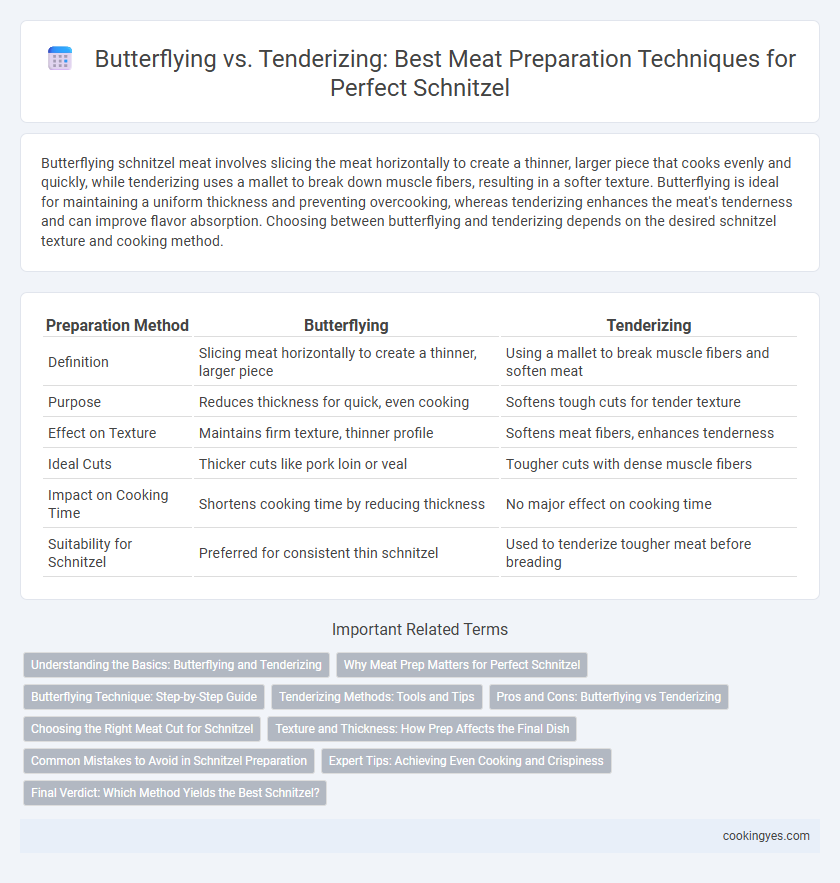Butterflying schnitzel meat involves slicing the meat horizontally to create a thinner, larger piece that cooks evenly and quickly, while tenderizing uses a mallet to break down muscle fibers, resulting in a softer texture. Butterflying is ideal for maintaining a uniform thickness and preventing overcooking, whereas tenderizing enhances the meat's tenderness and can improve flavor absorption. Choosing between butterflying and tenderizing depends on the desired schnitzel texture and cooking method.
Table of Comparison
| Preparation Method | Butterflying | Tenderizing |
|---|---|---|
| Definition | Slicing meat horizontally to create a thinner, larger piece | Using a mallet to break muscle fibers and soften meat |
| Purpose | Reduces thickness for quick, even cooking | Softens tough cuts for tender texture |
| Effect on Texture | Maintains firm texture, thinner profile | Softens meat fibers, enhances tenderness |
| Ideal Cuts | Thicker cuts like pork loin or veal | Tougher cuts with dense muscle fibers |
| Impact on Cooking Time | Shortens cooking time by reducing thickness | No major effect on cooking time |
| Suitability for Schnitzel | Preferred for consistent thin schnitzel | Used to tenderize tougher meat before breading |
Understanding the Basics: Butterflying and Tenderizing
Butterflying involves slicing the schnitzel meat horizontally to create a thinner, larger piece that cooks evenly and quickly. Tenderizing uses a meat mallet to break down muscle fibers, resulting in a softer texture and enhanced flavor absorption. Both techniques optimize schnitzel preparation by balancing thickness and tenderness for ideal crispness.
Why Meat Prep Matters for Perfect Schnitzel
Butterflying schnitzel meat ensures even thickness, allowing faster, uniform cooking and a crispier crust essential for authentic texture. Tenderizing breaks down muscle fibers, resulting in a more tender bite but may alter traditional schnitzel firmness. Precise meat preparation balances texture and flavor, making it critical for achieving the perfect schnitzel experience.
Butterflying Technique: Step-by-Step Guide
Butterflying schnitzel involves slicing the meat horizontally to create a thinner, larger piece that cooks evenly and quickly. Begin by placing the meat on a cutting board, then carefully slice through the middle without cutting all the way through, opening it like a book. This technique enhances tenderness and texture, preserving juiciness while ensuring a uniform thickness perfect for breading and frying.
Tenderizing Methods: Tools and Tips
Tenderizing schnitzel meat enhances tenderness by breaking down muscle fibers; common tools include meat mallets, rolling pins, and specialized tenderizer blades. Using a meat mallet with even, firm strokes ensures consistent thickness and texture without tearing the meat, while using a fork or needle tenderizer creates small punctures that improve marinade absorption. For best results, chill the meat before tenderizing and always work on a clean, sturdy surface to maintain control and hygiene.
Pros and Cons: Butterflying vs Tenderizing
Butterflying schnitzel involves slicing the meat horizontally to create a thinner, wider cut that cooks evenly and retains juiciness, but it may require a skillful hand to avoid tearing the meat. Tenderizing, by pounding with a meat mallet, breaks down connective tissue, resulting in a more tender texture but can cause the schnitzel to become overly thin and risk losing moisture. Choosing between butterflying and tenderizing depends on the cut of meat; butterflying works best for thicker cuts like pork loin, while tenderizing suits tougher cuts such as veal shoulder.
Choosing the Right Meat Cut for Schnitzel
Choosing the right meat cut for schnitzel is essential for achieving optimal texture and flavor; thin cuts like veal, pork loin, or chicken breast work best for butterflying because they allow for quick, even cooking. Tenderizing tougher cuts such as pork shoulder or round steak helps break down muscle fibers, resulting in a more tender schnitzel with a richer taste. Butterflying maintains the meat's juiciness by creating an even thickness, while tenderizing is ideal when using less naturally tender cuts that require softening before breading and frying.
Texture and Thickness: How Prep Affects the Final Dish
Butterflying schnitzel meat creates a thinner, more even cut that cooks quickly, resulting in a delicate, tender texture with a crispy crust. Tenderizing breaks down muscle fibers without significantly changing thickness, producing a juicier, more uniform bite while maintaining meat's original shape. Texture and thickness differences directly impact cooking time and mouthfeel, making the choice between butterflying and tenderizing essential for desired schnitzel quality.
Common Mistakes to Avoid in Schnitzel Preparation
Butterflying schnitzel meat too thin can cause uneven cooking and dryness, while over-tenderizing can break down the fibers excessively, leading to a mushy texture. Avoid using excessive force when pounding, as it compromises the meat's integrity and flavor. Consistently measure thickness around 1/4 inch to ensure perfect crispiness and juiciness.
Expert Tips: Achieving Even Cooking and Crispiness
Butterflying schnitzel meat creates a uniformly thin cut that ensures even cooking and enhances crispiness by increasing surface area for breading. Tenderizing with a meat mallet breaks down muscle fibers, resulting in a softer texture while maintaining thickness, which may require longer cooking times. Experts recommend butterflying for consistent crunch and tenderness, while combining it with gentle tenderizing can balance juiciness and texture perfectly.
Final Verdict: Which Method Yields the Best Schnitzel?
Butterflying schnitzel meat ensures even thickness and faster cooking, while tenderizing breaks down muscle fibers for enhanced juiciness and tenderness. The final verdict favors tenderizing for achieving the classic melt-in-your-mouth texture characteristic of authentic schnitzel. For optimal results, combine gentle tenderizing with precise butterflying to balance tenderness and consistent cooking.
Butterflying vs Tenderizing for schnitzel meat prep Infographic

 cookingyes.com
cookingyes.com